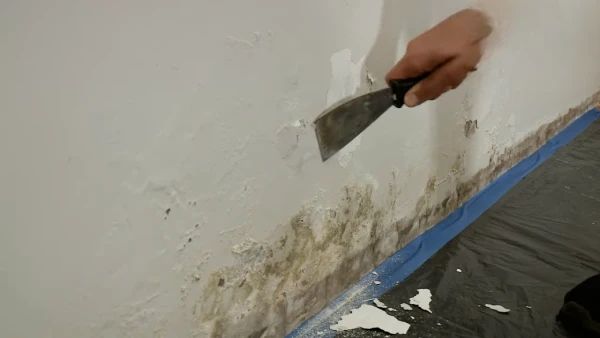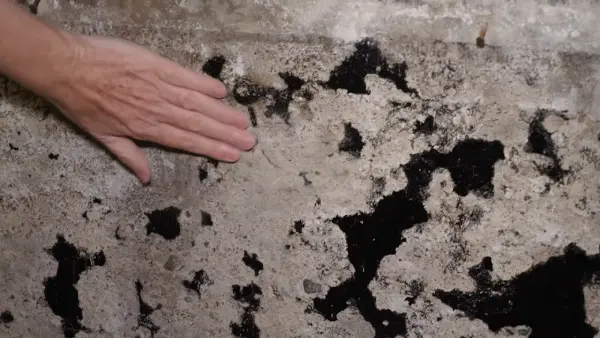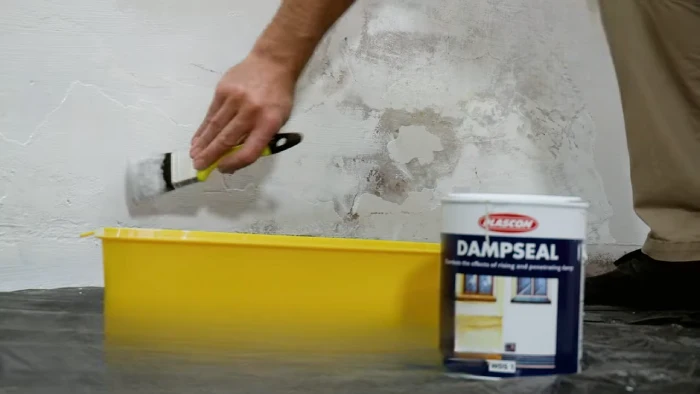Last Updated on February 6, 2023
If you’ve ever been in the middle of a concrete sealing project and it starts to rain outside, don’t worry. You can still seal your concrete even if it’s damp outside. Sealing your concrete is an important step, as it helps to protect it from weathering, staining and erosion.
Plus, it makes your space look much nicer, cleaner and more professional. However, there are some special considerations that you need to take into account when sealing concrete on a damp day. Read on to find out more.
When Can I Seal My Concrete if It’s Damp Outside: Factors to Consider
If you’re trying to seal your concrete when it’s damp outside, there are some things you need to consider first. Type of weather, moisture in the ground, temperature and humidity levels in the air can all affect how successful your sealing job will be.
Let’s take a look at each one of these factors and discuss when you can safely seal your concrete when it’s damp outside.
Type of Weather:
The type of weather you experience can have a huge effect on whether you can safely seal your concrete or not. If it’s raining or snowing heavily outside, then this isn’t ideal for sealing concrete. Constant rain or snow can prevent the sealer from properly adhering to the surface which could lead to cracking or peeling down the road.
Additionally, freezing temperatures aren’t ideal either as this could also cause problems with adhesion over time. As such, it’s best to wait until the weather is dry before attempting any type of sealing job on concrete.
Level of Moisture in the Ground:
Even if it isn’t raining or snowing outside, there could still be too much moisture in the ground for successfully sealing your concrete right away. When this happens, it’s important that you allow the ground enough time to dry out completely before attempting any type of sealing job.
You can check for moisture by sticking something like an old towel into areas that are prone to standing water; if it stays wet then there’s likely too much moisture in the ground and you should wait until conditions improve before trying again.
Temperature and Humidity Level in the Air:
Temperature and humidity levels in the air also play an important role when attempting to seal concrete outdoors. If temperatures get too high (generally above 90 degrees Fahrenheit) then this could create a situation where evaporation happens too quickly which in turn causes bubble formation leading to peeling off down the road due to poor adhesion properties.
In terms of humidity level, anything above 85% is considered too high for safe application as well since excessive humidity prevents proper curing from taking place; instead try waiting until humidity levels drop below 60-70%.
All these factors should be taken into consideration when deciding whether or not now is a good time for sealing your concrete outdoors when it’s damp outside.
If any one factor isn’t quite right then don’t attempt any type of sealing job as this can lead to problems with adhesion over time resulting in cracking/peeling off down the road.
Preparation for Sealing in Damp Conditions

Proper preparation and application of a sealer helps to ensure that your surfaces are effectively sealed and protected from water, dirt, and other substances. Here we will discuss the various steps involved in preparing a damp surface for sealing, including cleaning it and choosing the right sealer.
Cleaning the Surface
When preparing a surface for sealing in damp conditions, it is important to clean the area thoroughly before beginning. This will help to ensure that all dirt and debris are removed before you apply any kind of sealant or coating.
Cleaning may involve using a vacuum cleaner to remove loose dust particles or wiping down with a cloth soaked in warm soapy water, depending on the nature of the surface.
Additionally, all cracks or crevices should be washed out with either a pressure washer or brush and detergent to further remove any impurities. Once this step has been completed, it is important to allow adequate time for drying before moving on to apply any type of sealant or coating.
Choosing the Right Sealer
Once you have cleaned and prepared the surface for sealing, pick a sealant that is right for your needs. It should be flexible, let water vapor go through it, protect against sun damage, not be too bumpy or rough when touched, keep its original color over time and other things.
It’s important to understand which characteristics are needed according to your specific application so that you can make sure you choose an appropriate product for your project.
Furthermore, some types of coatings may require additional primers or adhesives prior to application so it’s also important to be aware of what materials have been used so that they can be compatible with each other.
Application of the Sealer in Damp Conditions
When applying sealer to a surface in damp conditions, it is essential to take the proper steps in order to ensure that the job is done correctly and thoroughly. In this section, we will explain how to apply sealer evenly and thoroughly in damp conditions, calculate the amount needed for coverage, and apply it at the appropriate temperature.
Applying Evenly and Thoroughly
Applying sealer in damp conditions requires extra care to ensure the sealer is distributed evenly across the entire surface. Generally, it is best to use a paint roller or large brush for larger surfaces or a brush for small areas.
It is important to apply an even layer of sealer by doing several passes over each area, moving up and down until there are no streaks or thin spots.
Additionally, when working on vertical surfaces, start from the bottom up as this helps avoid drips. Before continuing with more coats of sealers on damp surfaces, be sure any previous coat has dried completely so as not to cause any unevenness or bubbling.
Calculating Amount Needed for Coverage
When applying sealer in damp conditions it’s important to plan ahead and calculate how much sealer you need for adequate coverage of your desired surface area. To calculate approximately how much sealer you need, measure out your dimensions and multiply them together (length x width).
Once you have determined this number then divide it by 12 which will give you an approximate square footage total of what you will need covered with one gallon of sealer (1 gallon = 12 sq ft).
Keep in mind that when applying multiple coats of sealer an additional 10-20% may be needed as some seeps into the surface making up for any material lost due to evaporation or absorption during application.
Applying at Right Time and Temperature Conditions
The temperature when applying a water based sealer should remain between 40°F – 90°F (4°C – 32°C) depending on product manufacturer’s instructions; however if temperatures are too low then you may risk damaging your work due to freezing temperatures causing cracking or peeling off later down the line after drying has taken place.
On top of temperature control another factor needs consideration; humidity levels should remain between 40-50% as higher levels could lead to problems such as blistering, fading or dulling colors because moisture has been trapped under the surface layers creating pockets where water pooling can occur later on which would degrade overall quality/performance of your finish project.
Maintenance After Sealing in Damp Conditions

It is really important to take care of your surfaces after you seal them. Sealing can help protect them from water damage and make them last longer. But if you don’t maintain the sealant correctly, it won’t work as well and might need to be re-done sooner than you wanted.
This guide explains how to maintain damp surfaces to ensure their long-term protection.Our guide explains how to maintain damp surfaces to ensure their long-term protection.
Signs of Deterioration
When maintaining a surface that has been sealed in damp conditions, it’s important to look out for signs of deterioration on the surface itself. This can include discoloration of the sealant, cracking or peeling, or any other defect that may have occurred before or during the application of the sealant.
If you notice any signs of deterioration, then you should immediately address them by either repairing the damage or re-sealing the entire surface.
Additionally, if there is moisture present on the surface after sealing, this could indicate a problem with either improper application of the sealant or an inadequate level of protection against damp environments.
Cleaning and Inspecting Regularly
Regular cleaning and inspection are essential when it comes to maintaining a sealant in damp climates. You should clean off any dirt or debris build up regularly with a soft cloth and warm water solution, then inspect for any damage or changes in color or texture caused by moisture and humidity levels that may have altered during its application process.
You should also pay close attention to areas where moisture often collects such as corners or around window frames and make sure they are thoroughly dried after cleaning.
Additionally, if you notice any discoloration on your surface due to mold growth then you should immediately take action by using an appropriate cleaner and disinfectant solution made specifically for removing mold from walls and other surfaces before re-sealing them.
Reapplication Periodically
To ensure your surface remains protected from water damage for as long as possible, it is recommended that you reapply sealants periodically based on manufacturer instructions.
Reapplying takes into account factors like wear and tear over time caused by exposure to elements such as UV light, heat, cold temperatures, etc., which can all cause sealants to degrade more quickly than usual when used in damp environments.
If reapplication isn’t done regularly enough then your surface will start losing its protective properties which can lead to deterioration faster than normal so it’s important to monitor industry standards closely so you know exactly when reapplication needs to be done again depending on where you live geographically speaking.
Does concrete need to be completely dry before sealing?
Overall, ensuring that your concrete is completely dry before sealing will help ensure that your sealant will adhere properly and last for many years.
It’s important to ensure the concrete surface is completely dry before applying a sealant. This is because moisture can cause the sealant to fail earlier than it should. You also need to fill in any cracks or imperfections before sealing.
Wait at least 24 hours after pouring or finishing the concrete before applying a sealant, and use a moisture meter if you’re unsure if it’s dry enough. Doing this will help your sealant last longer.
What happens if you seal uncured concrete?

If you seal uncured concrete, it can cause the slab to become weak and porous. This can lead to cracking and other damage to the surface of the concrete. Additionally, sealing uncured concrete can prevent it from properly curing, which may result in a weaker finished product.
It is important to wait at least 30 days before applying any sealer to newly poured concrete so that it has time to fully cure. SEAL CURE-25 is a clear, UV-resistant, solvent-based sealer that is designed specifically for curing and sealing new concrete surfaces.
It helps protect the slab from environmental factors while also making it more resistant to freezing and thawing cycles.
What time of day is best to seal concrete?
Sealing concrete is an important part of protecting it from the elements and keeping it looking its best. The best time of day to seal concrete is in the morning or evening when temperatures are cooler and there is less direct sunlight.
It’s important to make sure that the concrete has had time to cure before applying a sealer, typically 28 days after pouring. Applying a sealer too soon can cause damage to the concrete as well as reduce the effectiveness of the sealer.
Is it better to roll or spray concrete sealer?
Rolling or spraying concrete sealer is a matter of preference. Spraying can be faster and more efficient, but rolling can provide a more even coverage. It’s important to consider the type of sealer you’re using when deciding which application method is best for your project.
When rolling, use a short nap roller that won’t leave behind lint or fuzz. Make sure to apply the sealer in an even coat, taking care not to over-apply it. When spraying, use an airless sprayer with a tip size appropriate for the job and make sure to keep the nozzle at least eight inches away from the surface.
No matter which application method you choose, always follow the manufacturer’s instructions for best results.
Seal Your Concrete in Any Weather
Sealing your concrete on a damp day is achievable but requires careful preparation and the right products.
It’s important to make sure that you select an appropriate weather-resistant sealer, ensure the surface moisture levels are low enough to safely apply it, and that you use protective clothing while working outdoors. By following these steps, you can successfully complete a seal coating job in any kind of weather.


